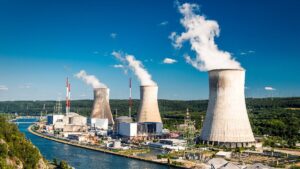Tribeca points to new US$80/lb floor for yellowcake

Pic: Getty Images
- The portfolio manager of Tribeca’s Nuclear Energy Opportunities Strategy says the uranium spot price has found a new base level at US$80/lb
- For near-term uranium producers, the price could be significantly higher at US$85-$90
- The current price levels appear viable but Guy Keller says there’s an obvious desire for prices to go higher
Regardless of what’s going on in global macro markets, Tribeca’s Guy Keller reckons the uranium spot price has found a new base above US$80/lb and wouldn’t be surprised to see prices in the third or further quarter hit the US$100-$120/lb range as utilities come back on.
For uranium developers with the ability to provide material in the near-term, the spot price floor could potentially be a little higher around the US$85-$90 mark given the severe lack in forthcoming uranium supply.
Positive market fundamentals, driven by the idea that nuclear energy is critical to reducing emissions, fuelled a major price rally for the glowing metal at the end of last year, after being stuck in the low US$50s for most of 2023.
From lows of ~US$18/lb in 2018, prices recovered slowly before more than doubling between January 2023 to 2024, hitting a 16-year high of US$107/lb after the strongest contracting year in a decade.
Spot prices have since pulled back, placing a seed of doubt that the bull run for uranium, a commodity renowned for its false dawns, could peter out early.
But while the current price levels appear viable, Keller says there’s an obvious desire for prices to go higher from a return-on-investment perspective and as construction costs soar due to inflation.
Price catalysts for junior exploration companies
“That’s why you’re not seeing a mad rush of new projects trying to come to market,” he says.
“Five years ago, the street consensus was that your medium-term incentive price was around $60 per pound, but what we’re seeing now with all these developers updating their financial and bankable studies is that the incentive price is significantly higher.
“You could argue the long-term price is now US$80 and that’s the absolute minimum a developer would be looking for on a contract negotiation,” Keller says.
“Some would be pushing for US$85 floor and $120-$125 ceiling or maybe even higher, US$90-$130, and the reality is, the utilities will have to accept that because there’s not much uranium around.”
He says part of the problem for exploration companies is the struggle to maintain relevance and attract capital, largely due to the uncertainty and volatility in broader markets.
“But that will change, we get a bit of seasonality in uranium markets around the timing of the World Nuclear Association symposium that’s held in London in September and this year we’re going to have [that] coinciding with Kazakh production guidance at the end of August,” Keller says.
“There’ll also be some clarity around what the waivers on the US ban on Russian imports look like for US utilities – those three things are all going to happen at the end of August, early September.
“I think that’s going to release activity in the physical market from the utilities which will bring focus back to spot price, which then gets people investing back into uranium names,” he says.
“Active explorers will be able to use that market sentiment and positive momentum to go and raise the money to drill.”
Koba set to drill at Yarramba in the coming days
Koba Resources (ASX:KOB) struck a deal with Havilah Resources (ASX:HAV) at the end of January to acquire an 80% interest in uranium rights of one of the hottest pieces of yellowcake real-estate in the country.
The 5,100km2 Yarramba project lies barely 120km southeast of the longstanding Beverley mine and immediately north of the high-grade Jason deposit being developed by uranium miner Boss Energy (ASX:BOE) at the Honeymoon operation.
With an existing resource of 8.2Mt at 260ppm U3O8 for 4.6Mlb at the Oban deposit, Yarramba boasts a strong foundation to build substantial resources given it is hosted within flat-lying carbonaceous and pyritic sands of the Eyre Formation at depths between 80m and 90m.
“We’re planning to drill around the resource towards the end of the month or early August once we have received the final permit, which we expect to have in the coming days,” KOB managing director Ben Vallerine told Stockhead.
“Drilling will also take place just 4km north of Boss Energy’s Jason deposit. We’re really looking forward to the drilling program – the project has massive exploration potential, and we’ve got a pipeline of targets to explore.”
KOB added the Harrier uranium project to its project portfolio in April, which resides in the same province in Canada (Newfoundland and Labrador) as market darling Infini Resources (ASX:I88).
Infini released eye-catching results from surface geochemistry at the Portland Creek project earlier this month with the best among them returning 74,997ppm uranium oxide.
“Nine of our prospects at Harrier have rock-chip results in excess of 1% U3O8, 50km west of Paladin’s 127Mlb Michelin uranium project,” Vallerine said.
“We rounded our inaugural sampling program in June and the assays of that are due in early August – and the planning for a follow-up program is already underway to define drilling targets.”
Active North America-focused uranium explorers
Under new management and with a proposed name change to ‘Strata Minerals’, NickelX (ASX:NKL) is looking to use funds from a recent $2m capital raising to conduct exploration works at the newly acquired Elliot Lake uranium project in Ontario, Canada.
The explorer already has boots on the ground across five of its prospects at Elliot Lake carrying out various programs such as mapping, sampling and drillhole sitting.
“Our first batch of samples have been sent to the laboratory currently awaiting analysis for uranium and rare earth elements with areas of focus being those where up to >360mlb U3O8 uranium has been produced from various mines,” NKL managing director Peter Woods told Stockhead.
Woods said the name ‘Strata Minerals’ was chosen to reflect the targeted uranium mineralisation style at the site, which is strata-bound and hosted in conglomerates.
These types of deposits, found in eight localities around the world, were a major source of primary uranium production for several decades after World War II.
Further south in Wyoming, GTI Energy (ASX:GTR) is moving forward with resource expansion drilling at the Lo Herma ISR uranium project after raising $2.25m via a placement of 500m shares to existing and new institutional and sophisticated investors in June.
All permits, bonds and access arrangements are now in place, with GTR set to begin drilling within the next 48 hours at Lo Herma, targeting the expansion and upgrade of the current 5.71Mlbs U3O8 inferred resource grading 630ppm.
“This work prepares GTI for a potential scoping study which we hope to commence later this year,” GTR executive director Bruce Lane says.
“We hope we can significantly grow the uranium resource to a similar scale to ISR uranium mines currently being constructed or planned at Ur-Energy’s Shirley Basin and Encore Energy’s Gas Hills project.”
Athabasca Basin explorer Thunderbird Resources (ASX:THB) raised $1.34m last week to fund exploration at the company’s flagship Hidden Bay and Surprise Creek uranium projects.
This follows a separate $4.1m raised via capital raising in early June.
With fieldwork programs underway, THB says it is now in the final stages of preparations to begin drilling at Hidden Bay in August to test a suite of basement-type uranium targets.
Active uranium explorers in OZ
Up in Australia’s top end, DevEx recently expanded its district-scale footprint of the Murthy West uranium project after entering into an earn-in agreement with Trek Metals (ASX:TKM).
The deal consolidates DEV’s prospective tenure along the southern margin of the McArthur Basin and to the west of the Westmoreland uranium project, and provides the opportunity for DEV to earn an 80% interest in the tenements once granted.
Meanwhile, a major campaign of RC and diamond drilling is continuing at the Narbarlek uranium project with new results being returned such as 7.5m at 1,821ppm U3O8 from 133.4m.
New drill targets are also emerging adjacent to the Nabarlek Fault Corridor, which hosts Australia’s highest-grade uranium mine (the historical Nabarlek mine).
Both RC and diamond drill rigs are currently at the U40 Prospect testing uranium mineralisation along the U40 Fault.
MEU is awaiting approvals to begin drilling at the Junction Dam uranium project in South Australia, 15km west of Boss Energy’s Honeymoon project.
A 75-hole drill program has been planned over the Yolanda area, the third major target area within Junction Dam featuring high-grade uranium mineralisation contained within floodplains on the sides of the palaeochannel as well as within the weathered sandstone basement near the palaeochannel.
Due to the small number of historical holes in this area, which missed the key palaeochannel as well as the corresponding floodplains, the full extent of uranium mineralisation remains largely untested to date.
Another exciting element about Yolanda is the fact that 8km of the main Eyre Formation runs straight through the prospect.
With a resource of 5.4Mlbs U3O8 grading 557ppm already at the project, MEU believes Yolanda provides significant scope for growth.
At Stockhead we tell it like it is. While Koba Resources, GTI Resources and Marmota are Stockhead advertisers, they did not sponsor this article.
Related Topics

UNLOCK INSIGHTS
Discover the untold stories of emerging ASX stocks.
Daily news and expert analysis, it's free to subscribe.
By proceeding, you confirm you understand that we handle personal information in accordance with our Privacy Policy.








